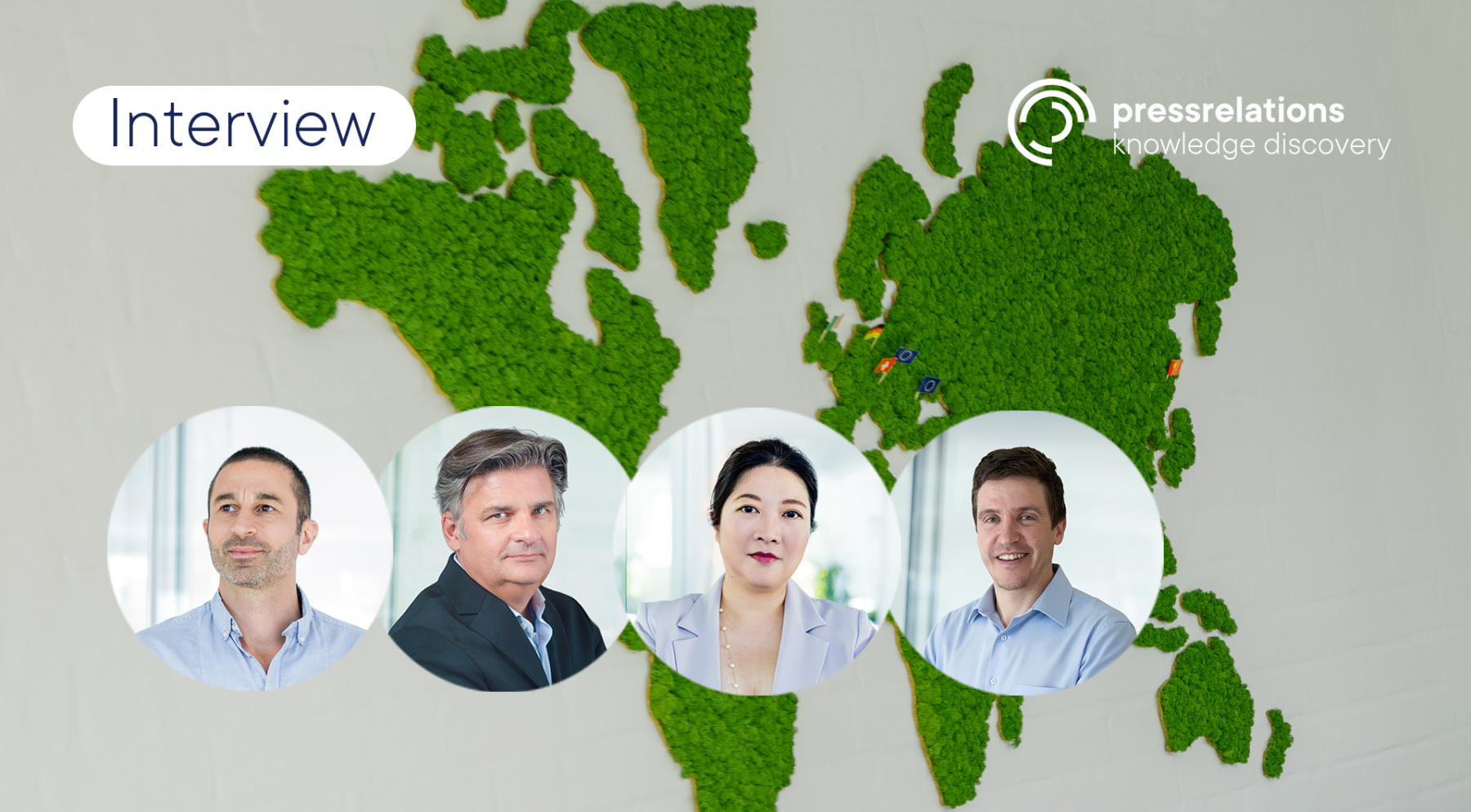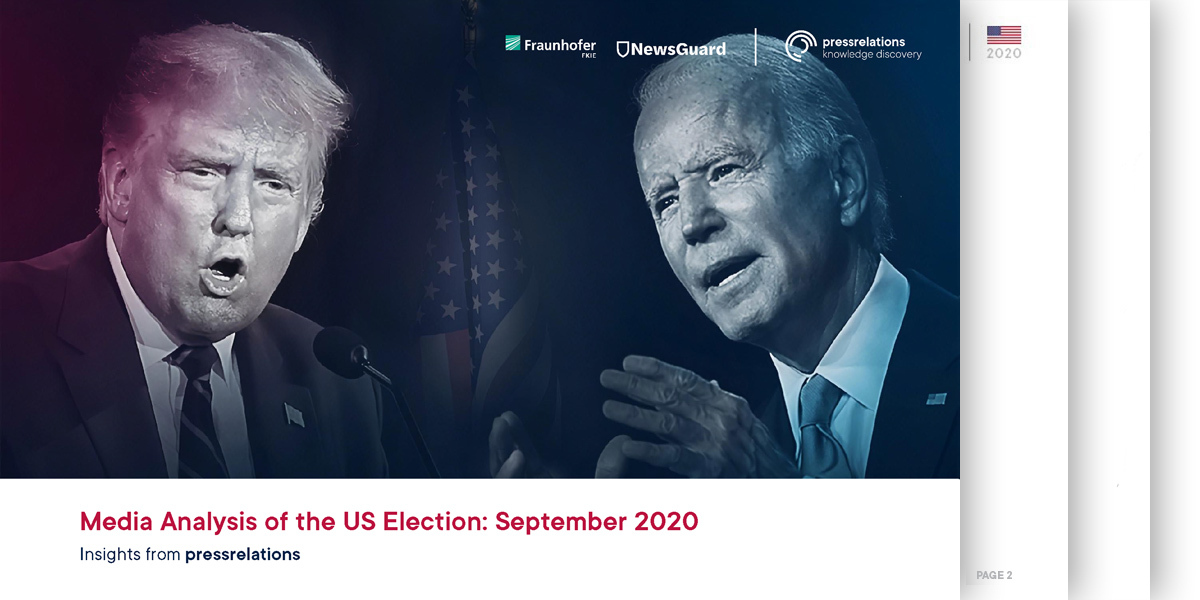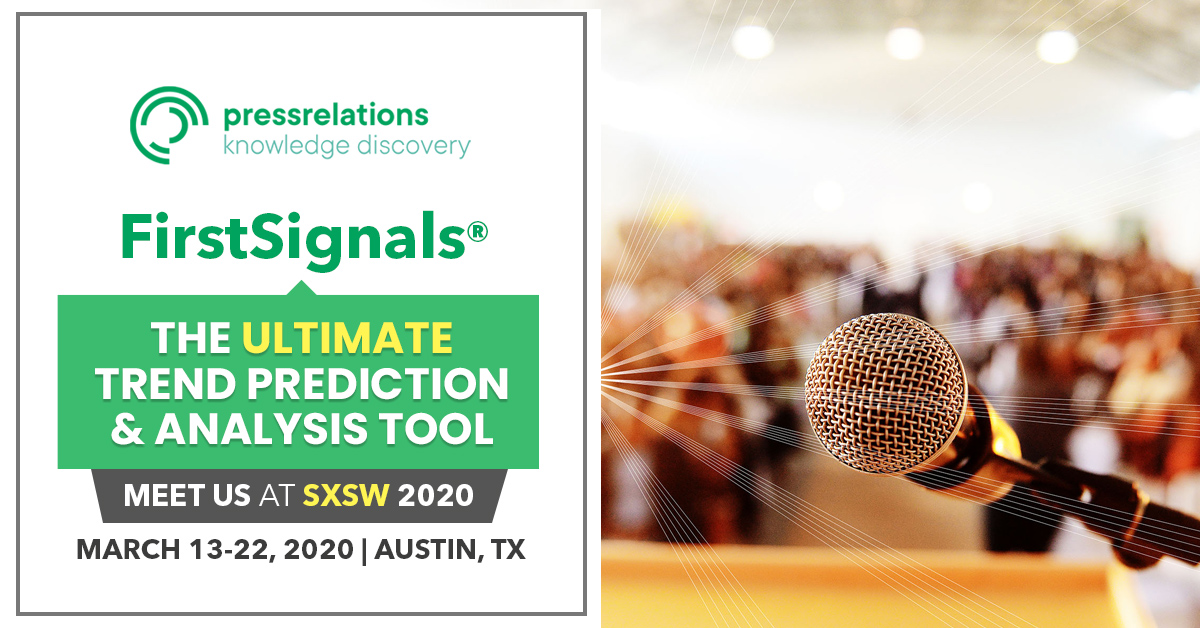In the run-up to the World Media Intelligence Congress 2025, taking place in Düsseldorf from September 30 to October 2, we exchanged views with colleagues from various locations on the latest developments in media monitoring and analysis. We spoke with Fady El-Murr (Managing Partner at pressrelations GmbH), Virginia Chen (Chief Operating Officer, Asia-Pacific), Johannes Burk (Head of Global Business Development, North America), and Christophe Dickès (Managing Partner France).
“The Day After Tomorrow – The Age of Information Overload” is the motto of this year’s congress. As hosts of this industry gathering, we wanted to find out how our colleagues assess the future of media intelligence in their respective countries, which topics shape their day-to-day work, and how they are experiencing the current changes.
Welcome, all four of you. Let’s dive right in: how do you perceive the current developments in the media intelligence industry worldwide? Are there any topics that, in your view, have gained particular momentum?
Fady El-Murr: The industry is currently very dynamic. There are many mergers and acquisitions taking place. And while many competitors are driven by investors, pressrelations has grown since its founding in 2001 as an independent, owner-managed company and focuses on sustainable development.
At the same time, the framework conditions for media have also gained momentum. Publishers and publications are looking for new revenue streams and trying to adapt their content to a digital world. This sometimes results in complex and opaque copyright regulations in different countries. In some countries, there are central licensing bodies such as the NLA in the UK. At the same time, individual media outlets, such as the London-based Financial Times, demand additional expensive license agreements with customers. In other countries, there are several licensing bodies – or no regulations at all. The New York Times, for example, has its own completely market-external ideas about the value of its content. From a customer perspective, this means higher licensing costs, but worse access to media content and full-text articles.
In this volatile copyright environment, we media monitoring providers occupy a special position. We take over copyright management for our clients, with compliance being a central issue. Media monitoring companies not only ensure that clients receive the content that matters to them, but also that they are properly advised on licensing. Beyond that, we play a central societal role: unlike any other industry, we are in a position to observe, make transparent, and contextualize the societal discourse taking place in the media.
Johannes Burk: The most obvious development that comes to mind is AI-driven automation. In light of the exponentially growing flood of information, our industry must provide precise solutions that filter, prioritize, and deliver actionable insights from media content in real time. Almost equally important is our mission to help combat misinformation.
Another trend is the role of earned media in shaping AI outputs. PR strategies must now consider not only how they reach a human audience, but also how they can be captured by LLM algorithms.
Christophe Dickès: The media intelligence industry is at a crossroads: it will become clear what will matter more in the long term – pure monitoring and the production of press reviews, or the delivery of tailored analyses of this content. Content is still king. But in today’s flood of information, content itself may become less important than our ability to interpret it and integrate it into communication strategies. If we as monitoring and analysis providers fail to meet this need, our clients will turn to other platforms. In this transformation, AI naturally plays a crucial role. However, when we talk about AI in our industry, we face pushback from publishers. It is up to us to anticipate and help shape this movement.
Virginia Chen: Traditional monitoring has already matured, as platforms and real-time analytics are now standard. What really drives the industry today is AI – it has evolved from a supporting tool to the very core of media intelligence. But AI also brings challenges, particularly around data ethics and credibility, as disinformation and AI-generated content become increasingly widespread.
At the same time, companies are demanding integrated views across news, social media, broadcast, and influencer content, which pushes the industry to deliver cross-channel analysis. Overall, our clients expect us not only to report on what has happened but also to provide actionable recommendations and forward-looking guidance.
“In this volatile copyright environment, we hold a special position as media monitoring providers.” – Fady El-Murr
In your opinion, what have been the biggest changes the industry has experienced over the past two to three years?
Virginia Chen: The rise of AI has fundamentally changed client expectations and the way media monitoring is applied. Service providers are now expected to deliver greater timeliness, higher accuracy, and improved cost efficiency. A monitoring report alone is no longer sufficient. Clients increasingly expect strategic insights as well. The focus has shifted from descriptive reporting (“what happened”) to analytical and predictive perspectives (“why it matters” and “what is likely to happen next”). What is crucial is that these insights can be integrated into daily workflows, enabling clients to turn information into concrete decisions. This development is pushing the industry beyond traditional monitoring toward a broader role in consulting and decision support.
Fady El-Murr: In addition to the complex country-specific copyright regulations and the AI-related changes already mentioned, the rise of AI-generated content – so-called pink slime media – stands out. These present further challenges and can distort media perception. Pink slime refers to websites that pose as credible news outlets but, in reality, distribute mostly machine-generated content. This can include political narratives or simply “nonsense content.” Because of AI, the costs of producing such content are extremely low. Here again, media monitoring providers play a central role in identifying such content.
Christophe Dickès: In short, the most important factor is our ability to integrate AI both in the back office and the front office. This also means changing the habits, processes, expertise, and roles of our colleagues – as well as the needs of our clients.
This transformation is currently underway, and we must take on an educational role – especially with clients in certain markets who do not always immediately recognize the associated challenges. For example, I am surprised that tenders in France are still very “traditional.” They look just as they did ten or twenty years ago! Yet our business has evolved considerably since then. Our challenge, therefore, is to build new understanding and to anticipate changing needs early on.
Johannes Burk: The mainstreaming and acceptance of AI is one of the most significant changes. Where there was once hesitation, clients are now increasingly expecting AI-driven solutions – while at the same time demanding transparency and methodological clarity. At pressrelations, we follow a hybrid approach: AI supports efficiency and speed, while human expertise ensures accuracy, context, and trust.
Another change is visible in media consumption behavior. Younger generations are increasingly relying on social platforms as their primary news source. This makes crisis communication and rapid response more important than ever. On social media, news spreads even faster than it already does elsewhere. This requires us to continuously adjust the speed of monitoring platforms in order to give our clients an edge.
At the same time, issues such as copyrights, content rights, and the rapidly changing media landscape remain structural challenges that the industry must continue to address collectively.
“At pressrelations, we follow a hybrid approach: AI supports efficiency and speed, while human expertise ensures accuracy, context, and trust.” – Johannes Burk
Looking ahead to the future of the media intelligence industry, what trends do you foresee? Do you think the focus will shift more toward SaaS, professional services, or could entirely new business models emerge?
Fady El-Murr: Both: Autonomous tool usage is just as in demand as service and consulting.
Johannes Burk: I see a hybrid model emerging that will likely persist for the foreseeable future. While pure SaaS can be attractive due to its scalability and cost efficiency, many clients still value solid consulting support offered alongside professional services. Especially when AI features are integrated into workflows, human expertise remains essential to review, interpret, and validate results. The ideal approach combines self-service flexibility with expert guidance on demand – technology paired with trusted know-how.
Virginia Chen: I believe it’s not moving toward a single model but rather a hybrid evolution. SaaS platforms will become the backbone of media intelligence, as clients require scalable, real-time, and user-friendly solutions. However, SaaS itself also needs to become more human-centered and intuitive, for example, by allowing users to access all features through a single interface.
At the same time, professional services remain indispensable. Technology doesn’t replace humans – it replaces repetitive, manual work. Valuable insights still require human expertise – cultural context, industry knowledge, strategic interpretation, and an understanding of client needs and workplace culture. These are aspects automation cannot fully replicate.
As a result, a new AI-driven model is emerging: platforms that combine the efficiency of SaaS with the depth of consulting. This allows clients to benefit from automated monitoring and analysis while receiving tailored, actionable recommendations. In short, the future will most likely be a mixed model.
“In short, the future will most likely be a mixed model.” – Virginia Chen
How do your clients respond to new technologies in media monitoring and analysis – with curiosity, skepticism, or enthusiasm for innovation?
Johannes Burk: It’s a mix, often shaped by the type of organization and the regulatory environment. Startups, agencies, and mid-sized companies are generally experimental and eager to test and adopt tools that give them a competitive edge. Larger corporations and government institutions, on the other hand, tend to be more cautious due to compliance requirements and risk management.
Across the board, however, we see a strong curiosity paired with healthy skepticism. This is where our role is crucial: we need to educate our clients about the potential, limitations, and transparency of data security in new technologies and guide them accordingly.
Christophe Dickès: In sales conversations, I encounter two reactions: on one hand, expectation when clients ask, “What else do you offer?” and on the other hand, surprise. Clients often say, “It’s only natural that AI is integrated.” Skepticism is rare; instead, there’s curiosity and excitement for innovation.
Virginia Chen: In my observation, clients in Asia – especially in China – show a high degree of openness to new technologies and are eager to explore the value AI and automation can bring to their workflows. At the same time, they remain very pragmatic and approach innovations with selective enthusiasm. There is often some skepticism, especially regarding data quality, transparency, and reliability. Clients want to derive real brand and consumer insights from data and naturally ask: Can I trust these analysis results? Is the system culturally sensitive? Will it truly help my team make better decisions?
However, once clients experience the tangible benefits of new technologies – particularly when innovations directly address their problems – their attitude quickly shifts toward strong support. In many cases, they go a step further by posing deeper and more demanding requirements, which in turn drives us to continuously innovate and improve the user experience.
“Skepticism is hardly present; instead, one feels curiosity and enthusiasm for innovation.” – Christophe Dickès
Before our conversation comes to an end, we would like to ask Fady: what does the World Media Intelligence Congress 2025 mean to you?
Fady El-Murr: The World Media Intelligence Congress is the largest international congress for media intelligence professionals. Participants travel from all continents. Despite its size, the congress traditionally takes place in a very familiar, welcoming atmosphere. Over the past few years, many professional friendships have been formed. I’m really looking forward to seeing old friends again and making new connections. This really captures what we aim for as hosts: creating an environment where all participants feel comfortable and can enjoy meaningful exchanges.
During the congress, there will be plenty of opportunities for sightseeing, a cocktail evening at our Düsseldorf office, a gala dinner, and many other occasions to engage in conversation.
Thank you all four for the conversation.



